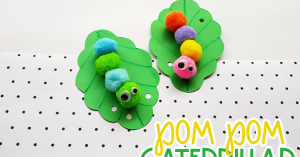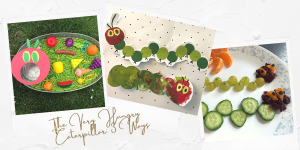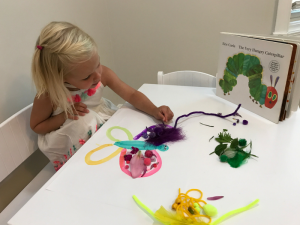Engaging preschoolers in creative and educational activities is a wonderful way to bring the beloved children’s book “The Very Hungry Caterpillar” by Eric Carle to life.
From arts and crafts to sensory play, science experiments, and movement games, these activities are designed to promote learning, fine motor skills, imagination, and a love for reading.
In this collection of creative the very hungry caterpillar preschool activities, we have gathered a range of exciting and interactive ideas to captivate young minds.
Join us on a colorful journey as we explore the world of the very hungry caterpillar and inspire a sense of wonder and curiosity in your preschoolers.
Caterpillar Crafts:

Let the little ones explore their artistic side by creating caterpillar-themed crafts. Provide them with various materials like colored paper, googly eyes, pom-poms, and pipe cleaners. They can cut out circles of different sizes and colors to make the caterpillar’s body segments. Using glue, they can stick on the eyes, add antennae using pipe cleaners, and attach pom-poms for legs. This hands-on activity encourages fine motor skills, color recognition, and creativity.
Healthy Food Sorting:

Inspired by the caterpillar’s insatiable appetite, introduce a sorting activity that focuses on healthy food choices. Prepare pictures or cutouts of different fruits and vegetables, and invite the children to sort them into two categories: foods that the caterpillar ate in the story and foods that it did not. Engage them in conversations about the importance of nutritious eating and how it contributes to their growth, just like the caterpillar’s transformation into a butterfly.
Related: 20 Exciting Communication and Language Activities for Toddlers
Butterfly Life Cycle Exploration:

Extend the learning from “The Very Hungry Caterpillar” by exploring the butterfly life cycle. Create a sensory bin filled with soil, small rocks, leaves, and plastic caterpillars, cocoons, and butterflies. Encourage the children to engage in pretend play, acting out the transformation from caterpillar to butterfly. They can bury the caterpillars in the soil, wrap them in cocoons, and finally release the beautiful butterflies into their natural habitat.
Story Sequencing:
Enhance storytelling skills and cognitive development by introducing a story sequencing activity. Print out or draw pictures representing the key events in the book, such as the caterpillar’s consumption of various foods, its stomachache, and its transformation into a butterfly. Mix up the pictures and ask the children to arrange them in the correct order. This activity not only reinforces comprehension but also enhances their ability to organize information sequentially.
Source: schooltimesnippets.com
Nature Hunt:
Take the preschoolers on a nature hunt inspired by the caterpillar’s exploration of the natural world. Provide magnifying glasses and small containers for collecting findings like leaves, twigs, and flowers. Encourage them to observe the different textures, colors, and shapes they encounter. During the hunt, discuss the importance of nature and how it provides food and shelter for various creatures, just like the caterpillar’s journey through different types of foliage.
Source: naturestudyhomeschool.com
Fruit and Vegetable Tasting:
Invite the children to experience a sensory adventure by organizing a fruit and vegetable tasting activity. Prepare a variety of fruits and vegetables that the caterpillar enjoyed in the story, such as apples, pears, strawberries, and carrots. Encourage the children to try each item and describe its taste, texture, and color. Discuss the importance of eating a rainbow of fruits and vegetables for a healthy and balanced diet.
Source: teachingexpertise.com
Counting Caterpillar:
Engage preschoolers in a counting and math activity using a “Counting Caterpillar” game. Cut out multiple circles from colored paper and write a number on each one. Attach the circles in a line, forming the body of the caterpillar. Provide small manipulatives like buttons, pom-poms, or cereal pieces for the children to place on each circle, corresponding to the number written on it. This activity helps reinforce number recognition and basic counting skills.
Source: powerfulmothering.com
Dramatic Play: Butterfly Dress-Up:
Encourage imaginative play by setting up a butterfly dress-up station. Provide colorful scarves, wings, and butterfly masks for the children to wear and transform into beautiful butterflies. Encourage them to flutter around, explore their surroundings, and engage in pretend conversations about their adventures as butterflies. This activity promotes creativity, language development, and social interaction.
Source: pbs.org
Butterfly Symmetry Art:
Inspire creativity and introduce the concept of symmetry through butterfly art. Fold a piece of paper in half and draw half of a butterfly’s body along the fold. Encourage the children to complete the other half by mirroring the design. Provide a variety of art supplies like paint, crayons, or colored pencils for them to decorate their butterflies. This activity not only enhances fine motor skills but also introduces the concept of symmetry in a visually engaging way.
Source: simplyfullofdelight.com
Caterpillar Movement Game:
Combine physical activity and learning with a caterpillar movement game. Designate a starting point and create a path with colored circles or mats spread out. Instruct the children to move like caterpillars by crawling from one circle to another, following a sequence or color pattern. For added fun, you can incorporate movements like wriggling, stretching, or spinning when they reach certain circles. This activity promotes gross motor skills, coordination, and following instructions.
Source: activelittles.com
Sensory Caterpillar Playdough:
Engage the senses and promote fine motor skills with sensory caterpillar playdough. Provide green playdough as the base and invite the children to mold and shape it into caterpillar bodies. Offer small beads, googly eyes, and pipe cleaners for them to add as decorations. Encourage them to explore the texture, stretch the play dough, and create different caterpillar designs. This activity stimulates creativity, sensory exploration, and hand-eye coordination.
Source: powerfulmothering.com
Caterpillar Alphabet Hunt:
Combine letter recognition with a fun scavenger hunt by organizing a caterpillar alphabet hunt. Hide paper cutouts of the alphabet letters around the room or outdoor area. Provide magnifying glasses for the children to search for hidden letters. As they find each letter, encourage them to name it, say a word that starts with that letter, or match it with a corresponding object. This activity reinforces letter recognition, vocabulary building, and observation skills.
Source: notimeforflashcards.com
Fruit and Vegetable Stamping:
Explore textures and colors while creating artwork with fruit and vegetable stamping. Cut various fruits and vegetables like apples, oranges, celery, and bell peppers in half to reveal their unique patterns. Dip them in washable paint and invite the children to stamp them onto paper, creating vibrant and textured prints. Encourage them to experiment with different combinations and discuss the shapes and patterns created by each fruit or vegetable.
Source: scholastic.com
Caterpillar Puzzles:
Boost problem-solving skills and cognitive development with caterpillar puzzles. Print or draw a picture of a caterpillar, then cut it into several pieces to create a puzzle. Provide the children with the puzzle pieces and encourage them to assemble the caterpillar by matching the shapes and colors. You can also adjust the difficulty level by cutting the caterpillar into smaller or larger pieces. This activity enhances spatial awareness, critical thinking, and hand-eye coordination.
Source: teachinglittles.com
Butterfly Garden: Create a mini butterfly garden to observe the life cycle and habitat of butterflies. Plant flowers that attract butterflies, such as milkweed or lavender, in a small garden area or pots. Set up a butterfly observation station with binoculars, magnifying glasses, and butterfly identification charts. Encourage the children to observe butterflies in their natural environment, noting their colors, patterns, and movements. This activity fosters an appreciation for nature, observation skills, and understanding of ecosystems.
Caterpillar Science Experiment:
Introduce a hands-on science experiment inspired by the transformation of a caterpillar into a butterfly. Provide clear containers or jars, caterpillar food (such as lettuce or cabbage), and caterpillars (from a reliable source). Allow the children to observe the caterpillars as they eat and grow, recording their observations in a science journal. Discuss the stages of metamorphosis and the changes they observe in the caterpillars over time. This activity encourages scientific inquiry, observation skills, and understanding of life cycles.
Source: lilbebeacademy.net
Caterpillar Shape Matching:
Promote shape recognition and matching skills with a caterpillar shape matching game. Cut out various shapes from colored paper and draw corresponding shapes on a long strip of paper, resembling a caterpillar body. Mix up the shape cutouts and ask the children to match each shape to the correct spot on the caterpillar’s body. This activity reinforces shape recognition, fine motor skills, and visual discrimination.
Source: twinkl.com.au
Caterpillar Dance Party:
Combine movement and music with a caterpillar dance party. Play lively and upbeat music while the children dance and imitate the movements of a caterpillar. Encourage them to wiggle, crawl, twist, and sway like a caterpillar in various creative ways. This activity promotes gross motor skills, coordination, rhythm, and self-expression.
Source: youtube.com
Sensory Storytelling:
Engage the senses and bring the story to life with sensory storytelling. As you read “The Very Hungry Caterpillar,” provide sensory elements that correspond to each part of the story. For example, offer real fruits and foods for the children to touch, smell, and taste when the caterpillar eats. Use fabric or textured materials to represent the caterpillar’s journey through different surfaces. Incorporate scented playdough or sensory bins filled with items related to the story. This multisensory experience enhances comprehension, language development, and engagement.
Source: theimaginationtree.com
Caterpillar Balloon Pop:
Organize a fun and active outdoor game with a caterpillar balloon pop. Blow up green balloons and draw caterpillar faces on each one. Scatter the balloons around an open space. Instruct the children to stomp on the balloons to pop them, imitating the caterpillar’s movement. They can also take turns using their hands or feet to keep the balloons in the air, like a caterpillar’s wriggling motion. This game promotes gross motor skills, coordination, and active play.
Source: thriftyfun.com


